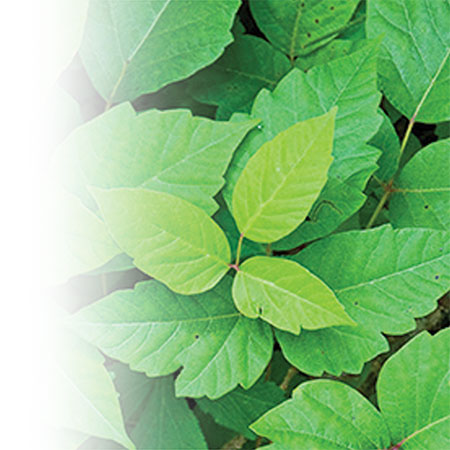Poison ivy is a common poisonous plant in North America, known to cause uncomfortable skin reactions. Here is everything you need to know to spot it, avoid contact and take effective action in case of exposure.
What is poison ivy?
Poison ivy is a widespread poisonous plant in Canada. It is mainly found in uncultivated areas, such as roadsides, ditches and nature trails, but can also grow around dwellings, both rural and urban.
This plant can be difficult to identify, as it varies considerably in appearance. It is typically bushy and thornless, measuring between 20 centimetres and 1 metre, depending on the variety. It has three leaves per stem, usually green, but can also be red or brown, and remains toxic even after the plant has died.
What are the symptoms of poison ivy?
The sap in different parts of poison ivy contains a toxic substance called urushiol. It provokes a strong skin reaction manifested, among other things, by:
- severe itching;
- a sensation of pain or burning;
- swelling and redness;
- blisters.
The typical reaction caused by urushiol may occur after:
- Direct contact with poison ivy (feet or legs are often affected);
- Indirect contact via contaminated clothing, tools, pets or other objects;
- Exposure to the smoke produced when the plant is burned.
How long does a reaction to poison ivy last?
Symptoms generally last between one to three weeks, depending on the severity of the reaction and exposure to urushiol. See your pharmacist if symptoms or skin reactions persist.
Can you be allergic to poison ivy?
Indeed, some people may have an increased sensitivity to urushiol and develop more severe than average allergic reactions. These cases usually require prompt medical attention to avoid complications.
Is a poison ivy infection possible?
Poison ivy itself doe not cause infection, but if the blisters or skin lesions caused by the urushiol (sap from the herb) are scratched or open, they can become infected from bacteria on the skin. Intense itching or skin lesions of this type require appropriate medical treatment.
Tip: After handling plants with potentially contaminated leaves such as poison ivy, it is important to clean the affected area. You can also clean your gardening tools and accessories with equal parts of white vinegar and water. This natural mixture helps neutralize the urushiol, which prevents future allergic reactions!
What is the difference between ragweed and poison ivy?
People often confuse poison ivy with ragweed. These plants are similar in that they are both weeds that can cause health problems.
- Ragweed triggers respiratory allergies due to its pollen, including "hay fever" in thousands of Canadians during the summer period. It does not cause skin reactions and can be handled safely with bare hands. Since ragweed is often found along the roadside and in vacant lots, outdoor activities and road trips can become a real nightmare for allergy sufferers.
- Poison ivy causes an inflammatory skin reaction when it comes into contact with the skin.
For more information on ragweed and related allergies, read the article How to recognize and treat ragweed allergy.
How to treat a reaction to poison ivy?
If you have been exposed, here are two simple steps to take before anything else:
- Remove contaminated clothing immediately;
- Wash affected skin thoroughly with warm water and soap.
What treatment should be applied in the event of a reaction?
- Avoid scratching, which can aggravate the itching;
- Apply a cold compress or take a lukewarm bath to relieve symptoms;
- Consult a pharmacist before using any product on irritated skin, to avoid aggravating symptoms;
- Use calming products such as calamine lotion, cortisone cream or antihistamines, if recommended.
In the event of an intense reaction, it may be advisable to consult a doctor. The latter may prescribe medication, depending on the nature and intensity of your symptoms.
Can poison ivy be spread from person to person?
The reaction to poison ivy is not contagious and cannot be spread between people. However, if urushiol is found on a person's skin or clothing, it could be transmitted to someone else, causing an allergic reaction.
How can I avoid a reaction to poison ivy?
The best way to avoid the discomfort of a poison ivy reaction is to learn how to recognize the plant and avoid contact with it. You can also take certain precautions:
- Wear boots or closed shoes and pants if you are walking in an area where poison ivy grows;
- Wear long clothing and waterproof gloves when gardening;
- Clean any clothing or items that have been in contact with the plant or its sap;
- Avoid burning the plant and its various parts.
If you think you have come into contact with poison ivy, consult a health care professional who can make a diagnosis and tell you what to do. Your pharmacist can also advise you on how to recognize poison ivy and what to do to get rid of the plant and treat the skin reaction it causes.
How do I get rid of poison ivy?
- Wear gloves and protective clothing;
- Carefully uproot the plants, taking care to remove all the roots;
- Bring the plants to your nearest Ecocentre;
- Never burn the plant, as the smoke may contain urushiol and cause severe reactions.
Allergic symptoms resurface when the summer arrives. To make the most of the summer season, it is essential to know how to recognize and effectively treat allergies of all kinds. For this, see also our article: Knowing how to distinguish allergens to better manage allergy symptoms.

